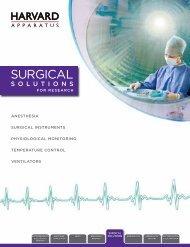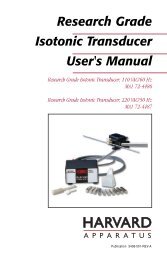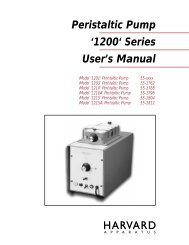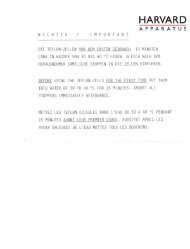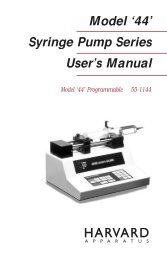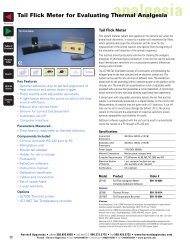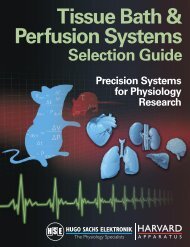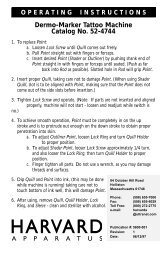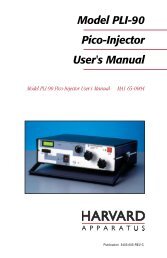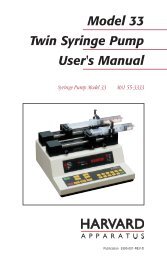to download the new 2011 Syringe Pump Catalog - Harvard ...
to download the new 2011 Syringe Pump Catalog - Harvard ...
to download the new 2011 Syringe Pump Catalog - Harvard ...
Create successful ePaper yourself
Turn your PDF publications into a flip-book with our unique Google optimized e-Paper software.
<strong>Harvard</strong> Apparatus<br />
Pulsatile Blood <strong>Pump</strong>s (continued)<br />
Pressure and Flow Curves Using <strong>Harvard</strong> Pulsatile Blood <strong>Pump</strong> for<br />
Dogs/Monkeys in Isolated Perfusion of Left Lower Lobe of Dog Lung*<br />
Pressure Curves<br />
The shape of <strong>the</strong> output pressure curve is a function of both <strong>the</strong> pump<br />
action and <strong>the</strong> characteristics of <strong>the</strong> external system on <strong>the</strong> output<br />
valve side. The following set of curves were obtained with Model<br />
1421, using water as <strong>the</strong> pumped medium. In <strong>the</strong> tests, “Sanborn”<br />
pressure transducers were inserted in three places, and continuous<br />
records obtained under varying conditions.<br />
Curve A Pressure just beyond <strong>the</strong> output valve<br />
Curve B Pressure within <strong>the</strong> pump chamber<br />
Curve C Pressure just before <strong>the</strong> intake valve<br />
By variation of parameters involved (peripheral resistance, stroke<br />
rate, stroke volume and phase ratio), an infinite number of output<br />
flow characteristics can be obtained.<br />
Hemolysis Test Conditions Models for Dog/Monkey<br />
(PC1 55-5321) and Large Animals (PC1 55-3305)<br />
Hemolysis ranged from 0.114 mg% <strong>to</strong> 0.29 mg% per pass through<br />
<strong>the</strong> various pumps, with an error of ±10%.<br />
To put <strong>the</strong>se results in perspective, most physiological perfusions are<br />
run with flow rates and <strong>to</strong>tal blood primes, such that <strong>the</strong> number of<br />
passes through <strong>the</strong> pump will range from about 1/4 <strong>to</strong> 3/4 per<br />
minute. Assuming one pass in two minutes and no physiological<br />
removal of <strong>the</strong> products of hemolysis, <strong>the</strong>n hemolysis rates would<br />
range from 3.4 mg% <strong>to</strong> 8.7 mg% per hour of pump use.<br />
In <strong>the</strong>se studies a reservoir of 500-800 cc of fresh dog blood was<br />
used, connected <strong>to</strong> <strong>the</strong> pump by 3/8” PVC tubing. Samples at room<br />
temperature were taken at 15 and 30 minute intervals for 4 <strong>to</strong> 5<br />
hours. Samples were spun down and hemolysis measured<br />
immediately using <strong>the</strong> method of Flink and Watson. Since <strong>the</strong> rate of<br />
hemolysis depends on <strong>the</strong> amount of blood in <strong>the</strong> system and <strong>the</strong><br />
flow rate, <strong>the</strong> results are reported as mg% per pass. The flow rate<br />
divided by <strong>the</strong> volume of blood in <strong>the</strong> system determines <strong>the</strong> number<br />
of passes through <strong>the</strong> pump per minute.<br />
Pa<br />
Pv<br />
Qpa<br />
Pa<br />
Pv<br />
Qpa<br />
Instrumentation:<br />
Pressure Statham<br />
Flow<br />
Pulmonary Artery Pressure<br />
Pulmonary Venous Pressure<br />
Pulmonary Artery Blood Flow<br />
Biotronex Electromagnetic Flowmeter<br />
Recording Electronics for Medicine<br />
*Note: The above data is supplied through <strong>the</strong> courtesy of Cardiorespira<strong>to</strong>ry<br />
labora<strong>to</strong>ry Columbia-Presbyterian Medical Center New York, New York,<br />
Dr. Alfred P. Fishman, Direc<strong>to</strong>r.<br />
72 <strong>Harvard</strong> Apparatus phone 508.893.8999 <strong>to</strong>ll free U.S. 800.272.2775 fax 508.429.5732 www.harvardapparatus.com




